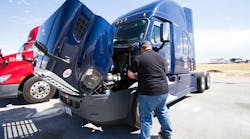I liken success in maximizing vehicle uptime to a three-legged stool. Each leg of the stool needs to be the same length for the stool to be balanced. And when it comes to truck maintenance, that means each of three areas needs to be given equal attention.
The three legs of good maintenance are:
- Proper pre- and post-trip inspections: Not only are pre- and post-trip inspections a Department of Transportation requirement, they are the first line of defense in discovering a problem with a truck. Today smart fleets are paying more attention to these inspections because they have found that when drivers are vigilant in performing their inspections there is a reduction in maintenance costs, fewer driver delays, a reduction in late deliveries and a reduction in negative maintenance points in CSA scores.
- Technician involvement: The best inspections and resulting data from those inspections are nearly worthless if someone does not act on the information that has been gathered. Technicians need to attend to the issues drivers raise during those pre- and post-trip inspections and take steps to fix problems. Technicians also need to be committed to performing quality PM service and be willing to identify and follow-up on any problems that surface during a PMI or during a scheduled PM service.
- Fleet manager attention: Fleet managers need to pay attention to data they are receiving from the trucks as they go down the road. Today’s fleet manager has near-real-time access to the operating condition of their vehicles. They need to monitor that data and take steps to act on problems as quickly as possible. That does not necessarily mean pulling a truck off the road immediately. It could mean scheduling the truck in for service when the driver gets back to the yard or having a technician look at a problem during the vehicle’s next scheduled PM service. The point is, fleet managers today have much better insight into what is happening with their trucks and they need to act on that data appropriately.
It takes all three of these elements to ensure trucks continue to operate efficiently. Failure in any one of the “legs” is going to lead to a wobbly “stool” which could mean a truck ends up with a Negative Maintenance Score during a roadside inspection or worse yet on the side of the road broken down causing a delay in deliveries, driver running out of hours of service, costly third-party repairs. Not all breakdowns are predictable but we certainly can reduce the occurrence.



